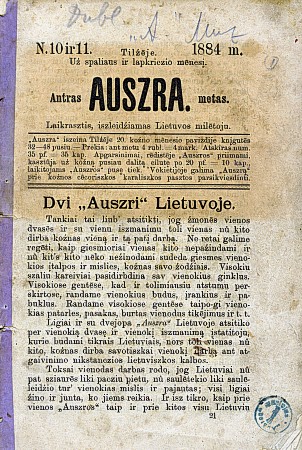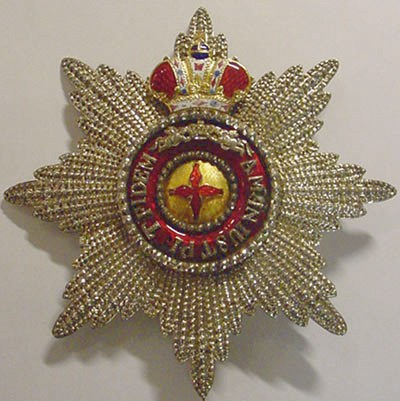|
Theodor Narbut
Teodor Narbutt (; 8 November 1784 – 27 November 1864) was a Polish–Lithuanian romantic historian and military engineer in service of the Russian Empire. He is best remembered as the author of a nine-volume Polish-language history of Lithuania from the early Middle Ages to the Union of Lublin. Life Teodor Narbutt was born in 1784 in the village of Voranava District, Szawry (present-day Voranava District of Belarus) in the Polish–Lithuanian Commonwealth, to a notable szlachta family of Trąby coat of arms. Early in his youth his fatherland was Partitions of Poland, partitioned between Russia, Austria and Prussia. After graduating from a Piarists, Piarist college at Lyubeshiv, Narbutt entered the Vilnius University, Vilna Academy, where in 1803 he graduated in engineering. He then moved to Saint Petersburg, where he joined the Cadet Corps. He served in the Imperial Russian Army, where he became a captain in the field engineering corps. He took part in the 1807 and 1812 Russian ... [...More Info...] [...Related Items...] OR: [Wikipedia] [Google] [Baidu] |
Maksymilian Fajans
Maksymilian Fajans (May 5, 1825 in Sieradz – July 28, 1890 in Warsaw) was a Polish people, Polish artist, lithographer and photographer. Fajans won several prizes at the International Photographic Exhibition organized in 1865 in Berlin and, in 1873, at the Vienna Exhibition. Life Fajans was born in Sieradz to Jewish parents and studied at Warsaw's School of Fine Arts (''Szkoła Sztuk Pięknych'') in 1844–49, and between 1850 and 1853 he worked and stationed in Paris, where he was a pupil of the Netherlands, Dutch–France, French painter Ary Scheffer. Fajans established one of the first photography studios in Warsaw. In 1851–63 he published 14 folios of ''Wizerunki polskie'' (Polish Images) after his own drawings, and in 1851–61, 24 folios of ''Wzory sztuki średniowiecznej'' (Images of Medieval Art) after drawings by L. Łepkowski, B. Podczaszyński and others. In chromolithography he published ''Kwiaty i poezje'' (Flowers and Poems, 1858, after his own drawings), ... [...More Info...] [...Related Items...] OR: [Wikipedia] [Google] [Baidu] |
Lyubeshiv
Liubeshiv (; ; ; ) is a rural settlement in Kamin-Kashyrskyi Raion, Volyn Oblast, western Ukraine. It is located in the historic region of Polesia. It is the administrative seat of Liubeshiv settlement hromada. Population: History Lubieszów was first mentioned in 1484. It was a private town of Grand Duchy of Lithuania, later part of Polish–Lithuanian Commonwealth. After the Partitions of Poland it was annexed by Russia. On 9 November 1943, 300 Poles were murdered by the Ukrainians as part of the genocide of Poles in Volhynia. A 2013 monument on the local Polish cemetery commemorates the victimsGrzegorz Rąkowski, "Wołyń", page 77 Until 26 January 2024, Liubeshiv was designated urban-type settlement. On this day, a new law entered into force which abolished this status, and Liubeshiv became a rural settlement. Lubiašoŭ, Rynak-Zamkavaja. Любяшоў, Рынак-Замкавая (1915).jpg, Liubeshiv in 1915 Liubeshiv Volynska-Polish cemetery-central monument-1.jpg ... [...More Info...] [...Related Items...] OR: [Wikipedia] [Google] [Baidu] |
Lithuanian National Revival
The Lithuanian National Revival, alternatively the Lithuanian National Awakening or Lithuanian nationalism (), was a period of the history of Lithuania in the 19th century, when a major part of Lithuanian-inhabited areas belonged to the Russian Empire (the Russian partition of the Polish–Lithuanian Commonwealth). It was expressed by the rise of self-determination of the Lithuanians that led to the formation of the modern Lithuanian nation and culminated in the re-establishment of an independent Lithuanian state. The most active participants of the national revival included Vincas Kudirka and Jonas Basanavičius. The period largely corresponded to the rise of romantic nationalism and other national revivals of 19th-century Europe. The revival was predated by a short period of the early 19th century known as the "Samogitian revival" led by students of Vilnius University, including Simonas Daukantas and Simonas Stanevičius. The most recent Lithuanian national revival may be ... [...More Info...] [...Related Items...] OR: [Wikipedia] [Google] [Baidu] |
Aleksander Bychowiec
Aleksander Bychowiec of Mogiła () was a Russian-Polish noble and an amateur historian of the Russian Empire from the Grodno Governorate. He is best known as the discoverer (and the name-sake) of the so-called Bychowiec Chronicle, a set of 16th-century texts related to the history of the Grand Duchy of Lithuania. Family * Casimir * Stanislaw Joseph Daniel (1829-1883), a Major General of the Russian Imperial Army The Imperial Russian Army () was the army of the Russian Empire, active from 1721 until the Russian Revolution of 1917. It was organized into a standing army and a state militia. The standing army consisted of Regular army, regular troops and ... References People from Pruzhany district Year of birth missing 1863 deaths 19th-century Polish nobility Belarusian nobility 19th-century Polish historians Polish male non-fiction writers Belarusian male writers Historians of Lithuania Male non-fiction writers {{Russia-historian-stub ... [...More Info...] [...Related Items...] OR: [Wikipedia] [Google] [Baidu] |
Bychowiec Chronicle
The ''Bychowiec Chronicle'' (; ; also spelled ''Bykhovets'', ''Bykovets'' or '' Bychovec'') is an anonymous 16th-century chronicle of the Grand Duchy of Lithuania. Although one of the least reliable sources of the epoch, it is considered the most extensive redaction of the Lithuanian Chronicles. It is named after its discoverer. Origin and publication The chronicle was most probably authored between 1519 and 1542, though some parts continued to be added until 1574. Authors of the chronicle are not known. The text highlights achievements of the Goštautai and Olshanski families, particularly to Jonas Goštautas. Therefore, scholars concluded that it was sponsored by a member of these families. Scholars proposed Grand Chancellor Albertas Goštautas, Bishop Paweł Holszański, and Duke Olelkovich. Aleksander Bychowiec, a 19th-century Polish noble and historian, discovered the chronicle in 1830 and it is now known by his name. Teodor Narbutt studied, copied and published it i ... [...More Info...] [...Related Items...] OR: [Wikipedia] [Google] [Baidu] |
History Of Lithuania
History is the systematic study of the past, focusing primarily on the human past. As an academic discipline, it analyses and interprets evidence to construct narratives about what happened and explain why it happened. Some theorists categorize history as a social science, while others see it as part of the humanities or consider it a hybrid discipline. Similar debates surround the purpose of history—for example, whether its main aim is theoretical, to uncover the truth, or practical, to learn lessons from the past. In a more general sense, the term ''history'' refers not to an academic field but to the past itself, times in the past, or to individual texts about the past. Historical research relies on primary and secondary sources to reconstruct past events and validate interpretations. Source criticism is used to evaluate these sources, assessing their authenticity, content, and reliability. Historians strive to integrate the perspectives of several sources to devel ... [...More Info...] [...Related Items...] OR: [Wikipedia] [Google] [Baidu] |
Grand Duchy Of Lithuania
The Grand Duchy of Lithuania was a sovereign state in northeastern Europe that existed from the 13th century, succeeding the Kingdom of Lithuania, to the late 18th century, when the territory was suppressed during the 1795 Partitions of Poland, partitions of Poland–Lithuania. The state was founded by Lithuanians (tribe), Lithuanians, who were at the time a Lithuanian mythology, polytheistic nation of several united Baltic tribes from Aukštaitija. By 1440 the grand duchy had become the largest European state, controlling an area from the Baltic Sea in the north to the Black Sea in the south. The grand duchy expanded to include large portions of the former Kievan Rus' and other neighbouring states, including what is now Belarus, Lithuania, most of Ukraine as well as parts of Latvia, Moldova, Poland and Russia. At its greatest extent, in the 15th century, it was the largest state in Europe. It was a multinational state, multi-ethnic and multiconfessionalism, multiconfessional sta ... [...More Info...] [...Related Items...] OR: [Wikipedia] [Google] [Baidu] |
Archaeology
Archaeology or archeology is the study of human activity through the recovery and analysis of material culture. The archaeological record consists of Artifact (archaeology), artifacts, architecture, biofact (archaeology), biofacts or ecofacts, archaeological site, sites, and cultural landscapes. Archaeology can be considered both a social science and a branch of the humanities. It is usually considered an independent academic discipline, but may also be classified as part of anthropology (in North America – the four-field approach), history or geography. The discipline involves Survey (archaeology), surveying, Archaeological excavation, excavation, and eventually Post excavation, analysis of data collected, to learn more about the past. In broad scope, archaeology relies on cross-disciplinary research. Archaeologists study human prehistory and history, from the development of the first stone tools at Lomekwi in East Africa 3.3 million years ago up until recent decades. A ... [...More Info...] [...Related Items...] OR: [Wikipedia] [Google] [Baidu] |
Order Of Saint Anna
The Imperial Order of Saint Anna (; also "Order of Saint Anne" or "Order of Saint Ann") was a Holstein ducal and then Russian imperial order of chivalry. It was established by Karl Friedrich, Duke of Holstein-Gottorp, on 14 February 1735, in honour of his wife Anna Petrovna, daughter of Peter the Great of Russia. Originally, the Order of Saint Anna was a dynastic order of knighthood; but between 1797 and 1917 it had dual status as a dynastic order and as a state order. The Order of St. Anna continued to be awarded after the revolution by Grand Duke Kirill Vladimirovich, Grand Duke Vladimir Kirillovich, and Grand Duchess Maria Vladimirovna. Today, the Russian Imperial Order of St. Anna, awarded by Grand Duchess Maria Vladimirovna is recognized as an order of chivalry by the privately operated ICOC as a continuation of the pre-Revolutionary order, and has been approved for wear with military uniform by the Russian Federation, but not by some members of the Romanov Family Association ... [...More Info...] [...Related Items...] OR: [Wikipedia] [Google] [Baidu] |
Babruysk Fortress
Babruysk Fortress (; ) is a historic fortress in the city of Babruysk, Belarus, that was built between 1810 and 1836. It is one of the best surviving examples of fortification architecture and design in the first half of the 19th century. The fortress was constructed in the historic center of the city, at the confluence of the Babruyka river, Babruyka and Berezina river, Berezina rivers. It was one of the western Russian fortresses. In 1810, Alexander I of Russia, Tsar Alexander I sent out his military engineer Teodor Narbutt to find a site suitable for building a fortress somewhere on the Dnieper, between Mogilev and Rogachev in order to prepare for the looming threat in Western Europe. However, after his investigation, Narbut advised his superiors that a more strategic position would be on the shore of the Berezina river near Babruysk. This decision was approved by the Chief of Military Engineers, Count Carl Operman, who at the time had authority over all of Russian forts. O ... [...More Info...] [...Related Items...] OR: [Wikipedia] [Google] [Baidu] |
Napoleon Bonaparte
Napoleon Bonaparte (born Napoleone di Buonaparte; 15 August 1769 – 5 May 1821), later known by his regnal name Napoleon I, was a French general and statesman who rose to prominence during the French Revolution and led Military career of Napoleon, a series of military campaigns across Europe during the French Revolutionary and Napoleonic Wars from 1796 to 1815. He led the French First Republic, French Republic as French Consulate, First Consul from 1799 to 1804, then ruled the First French Empire, French Empire as Emperor of the French from 1804 to 1814, and briefly again in 1815. He was King of Italy, King of Kingdom of Italy (Napoleonic), Italy from 1805 to 1814 and Protector of the Confederation of the Rhine, Protector of the Confederation of the Rhine from 1806 to 1813. Born on the island of Corsica to a family of Italian origin, Napoleon moved to mainland France in 1779 and was commissioned as an officer in the French Royal Army in 1785. He supported the French Rev ... [...More Info...] [...Related Items...] OR: [Wikipedia] [Google] [Baidu] |







